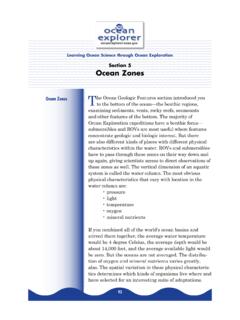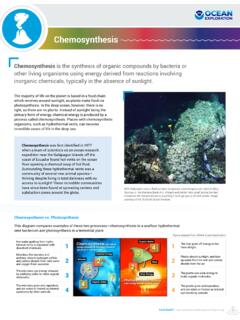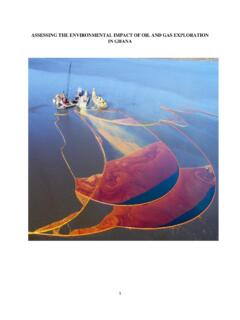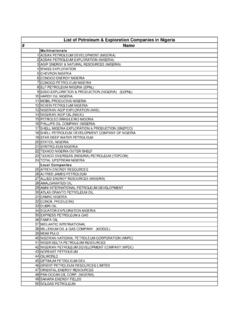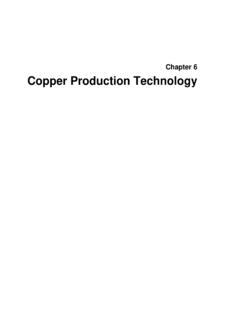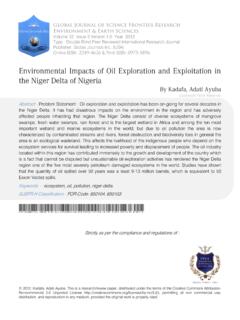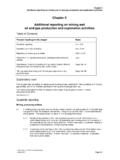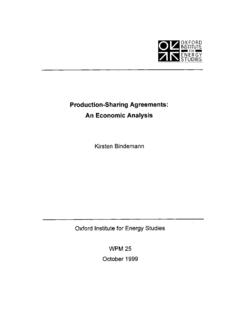Transcription of Section 6 Ocean Primary Production
1 111 Every ecosystem requires an input of energy. The source varies with the system. In the majority of Ocean ecosystems the source of energy is sunlight that drives photosynthesis done by micro- (phytoplankton) or macro- (seaweeds) algae, green plants, or photosynthetic blue-green or purple bacteria. These organisms produce ecosystem food that supports the food chain, hence they are referred to as Primary producers. The balanced equation for photosynthesis that is correct, but seldom used, is 6CO2 + 12H2O = C6H12O6 + 6H2O + 6O2. Water appears on both sides of the equation because the water molecule is split, and new water molecules are made in the process. When the correct equation for photosynthe-sis is used, it is easier to see the similarities with chemo-synthesis in which water is also a product. There are some ecosystems that depend on Primary Production from other ecosystems.
2 Many streams have few Primary producers and are dependent on the leaves from surrounding forests as a source of food that supports the stream food chain. Snow fields in the high mountains and sand dunes in the desert depend on food blown in from areas that support Primary Production . The oceans below the photic zone are a vast space, largely dependent on food from photosynthetic Primary producers living in the sunlit waters above. Food sinks to the bottom in the form of dead organisms and bacteria. It is as small as marine snow tiny clumps of bacteria and decomposing microalgae and as large as an occasional bonanza a dead Ocean Science through Ocean ExplorationSection 6 Ocean Primary ProductionPhotosynthesisSystems Lacking Primary Producers112 Learning Ocean Science through Ocean ExplorationSection 6: Ocean Primary exploration has brought to light new ecosystems, dependent on chemosynthetic bacteria which produce food from CO2 (and sometimes water) using energy from the metabolism of inorganic materials found around them.
3 Chemosynthesis was already well known in ter-restrial systems. Nitrifying and anaerobic denitrifying bacteria as well as sulfur-fixing and anaerobic sulfur-re-ducing bacteria all use energy sources other than the sun. These bacteria had been studied in terrestrial and shal-low water systems, but finding entire large ecosystems in the deep sea dependent on chemosynthetic bacteria using sulfur and methane as substrates opened major new areas of research. The discovery of hydrothermal vents and coldwater methane seeps has given us a new vision of Primary Production in the deep vents hot springs associated with spreading ridges on the sea floor support exotic chemical-based ecosystems. The thriving communities associated with these vents shocked the scientific world when humans first observed a vent on the deep Ocean floor in 1977. These vent ecosystems depend on microbes that use chemical energy available in the minerals from the hot spring water.
4 Since they depend upon chemicals for energy instead of the sun, these autotrophic vent-dwelling microbes are called chemoautotrophs. Sulfur in the form of hydrogen sulfide is an energy rich, but toxic molecule. Bacteria that use hydrogen sulfide as an energy source are important to most vent food chains. They exist as both free-living organisms and as mutualistic symbionts within animals. The equation for chemosynthesis based on hydrogen sulfide is 6CO2 + 24H2S + 6O2 = C6H12O6 + 24S + 18H2O. The vent food chain supported by chemosynthetic bacteria includes shrimp, tubeworms, clams, fish, crabs, and octopi. These animals are well adapted to the extreme vent environment complete darkness, water temperatures ranging from the 2 C of the surrounding seawater to 400 C at the vent, hundreds of atmospheres of pressure, ChemosynthesisHydrothermal Vent Ocean Science through Ocean ExplorationSection 6: Ocean Primary Production113and high concentrations of sulfides and other toxic irony is that once scientists knew what to look for, they went to other well-known ecosystems that were rich in hydrogen sulfides, such as salt marshes, and found the same mutualistic association of chemosynthetic bacteria and animals that had stunned them in the deep vents.
5 No one had ever thought to look for them, but they were there all photosynthesis and chemosynthesis require an energy source and use carbon dioxide as a source of carbon to synthesize sugars and new water molecules. Photosynthesis gives off oxygen gas as a by-product, while chemosynthesis produces a wide variety of by-products, depending on what chemical substrate is used. The sugars produced provide both metabolic energy and substrate for synthesis of other biochemical molecules. Hydrothermal vents have a number of kinds of lithotrophic (chemical-eating) bacteria associated with them in addition to those that use hydrogen sulfide since hydrothermal vents release many inorganic compounds to the surrounding seawater. Not all hydrothermal vents are the same. The very hot vents are called black smokers because some of the minerals released precipitate out as a black cloud in the surrounding colder water.
6 They have high flow rates and very hot water, in addition to the variety of chemicals released. Other vents have cooler temperatures and different chemicals. The Lost City Hydrothermal Field near the Mid-Atlantic Ridge emits fluids at 40 to 75 degrees C and builds carbonate towers up to 60 m bacteria isolated from deep hydrothermal vents include those that oxidize hydrogen sulfide as well as nitrifying, hydrogen oxidizing, and iron and manganese-oxidizing bacteria. Methylotrophic bacteria 114 Learning Ocean Science through Ocean ExplorationSection 6: Ocean Primary use methane as an energy source also occur there. Those that use hydrogen sulfide are the most studied, in part because they are symbionts in the giant tubeworms. Many of the free-living lithotrophic bacteria form mats around the vent and are grazed upon directly by animals, so they also contribute to Primary Production around a deep water seeps form above methane hydrate deposits.
7 Communities develop around methane seeps that depend on the energy from hydrogen sulfide and methane captured by bacteria. Dense huge thickets of organisms surround the seeps. Animals from the nearby Ocean may come and feed here as well as those that live only in the seep Section includes several activities related directly to Primary Production in the Ocean both by photosyn-thesis and chemosynthesis. Additional exercises found on the OE web site or OE CD include: Message in the Bottles from the 2002 Arctic Ocean exploration Rock Eaters of the Gulf of Alaska in Exploring Alaska s Seamounts 2002 From the Gulf of Mexico to the Moons of Jupiter in the 2002 Gulf of Mexico expedition Candy Chemosynthesis in Submarine Ring of Fire 2002 It s a Gas from Deep East 2001 and Hudson Canyon 2002 Cold SeepsWhere to Find More Activities on Ocean Primary Ocean Science through Ocean ExplorationSection 6: Ocean Primary ProductionFocusPrimary productivity and limiting factorsFocus QuestionWhat factors limit Primary productivity in the Arctic Ocean ?
8 Learning objectivesStudents will identify the major factors that limit Primary productivity in the Arctic Ocean and will describe how these factors exert limiting will infer which factors are limiting in a data set of potentially limiting factors and Primary inFormation For teachers oF deaF studentsIn addition to the words listed as Key Words, the fol-lowing words should be part of the vocabulary list:Algae Photosynthesis ChemosynthesisThe words listed as Key Words are integral to the unit and will be used in the first step of the Learn-ing Procedure. They are really the material that will become the basis of the lesson. There are no formal signs in American Sign Language for any of these words and many are difficult to lipread. Having the vocabulary list on the board as a reference during the lesson will be extremely Five sets of Sample Data Cards one for each student group One Data Summary Sheet for each groupaudio/visuaL materiaLs Noneteaching timeOne or two 45-minute class periodsseating arrangementFive groupsKey WordsPelagicBenthicZooplanktonPrimary productivityPhytoplanktonPARC hlorophyll abacKground inFormationThis activity focuses on Primary productivity in the pelagic realm of the Arctic Ocean .
9 Primary productivity refers to the amount of organic matter, usually expressed as grams of carbon per square meter per day, produced by organisms that make food from simple inorganic substances using energy from sunlight to conduct photosynthesis or the chemical reactions of chemosynthesis. Primary productivity in the Arctic Ocean is largely due to photosynthesis carried out by microscopic drifting algae called phytoplankton. Photosynthesis requires photosynthetic organisms, light, carbon Lesson Plan 15 Being Productive in the Arctic Ocean116 Learning Ocean Science through Ocean ExplorationSection 6: Ocean Primary , water, and mineral nutrients. Lack of any one of these may limit photosynthesis or Primary Production . Which factors limit Primary Production in the Arctic Ocean ? How much Primary Production actually occurs? This activity uses data from a scientific paper: Smith, Jr.
10 , W. O. 1995. Primary productivity and new Production in the Northeast Water (Greenland) Polynya during summer 1992. Journal of Geophysical Research 100: 4357-4370. It enables your students to examine the factors that limit Primary Production using real Arctic Ocean is the smallest of the world s four Ocean basins. It is not easily explored as it is almost entirely covered with ice for eight months of the year, a drifting polar ice pack covers the central and western portions year-round, and sea temperature seldom rises above 0 C. Organisms living in the water column between the Ocean surface and the bottom, largely phytoplankton, conduct most of the Primary Production in the pelagic water. Melting sea ice allows increased light to enter the sea. Algae grow rapidly since the sun shines for 24 hours a day during the summer. Through photosynthesis, these phytoplankton provide energy for a variety of drifting animals (zooplankton) that include crustaceans and jellyfish.
